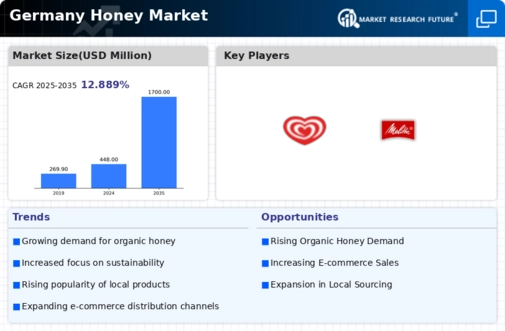Culinary Trends and Gourmet Products
The growing interest in gourmet food products is influencing the honey market in Germany. Consumers are increasingly exploring unique flavors and artisanal honey varieties, which may lead to a diversification of product offerings. This trend is supported by the rise of food festivals and culinary events that showcase local honey producers. As consumers seek out premium and specialty honey products, the market could see an increase in sales of infused or flavored honey. This shift indicates that the honey market is evolving to cater to the sophisticated tastes of consumers who appreciate high-quality, gourmet food experiences.
Health Consciousness Among Consumers
The increasing awareness of health benefits associated with honey consumption appears to be a driving force in the honey market. Consumers in Germany are increasingly seeking natural sweeteners as alternatives to refined sugars, which may lead to a rise in demand for honey products. According to recent data, the organic honey segment has seen a growth rate of approximately 15% annually, reflecting a shift towards healthier dietary choices. This trend suggests that the honey market is likely to benefit from the growing preference for natural and organic products, as consumers prioritize health and wellness in their purchasing decisions.
E-commerce Growth and Digital Marketing
The rise of e-commerce platforms is transforming the honey market in Germany. With more consumers turning to online shopping, honey brands are increasingly leveraging digital marketing strategies to reach a broader audience. Recent statistics indicate that online sales of honey products have surged by over 20% in the past year, reflecting a shift in consumer purchasing habits. This trend suggests that businesses in the honey market must adapt to the digital landscape to remain competitive. By utilizing social media and targeted online advertising, brands can effectively engage with consumers and drive sales in this evolving market.
Regulatory Support and Quality Standards
Regulatory frameworks in Germany are playing a crucial role in shaping the honey market. The government has established stringent quality standards for honey products, ensuring consumer safety and product integrity. This regulatory support may enhance consumer trust in honey brands, potentially leading to increased sales. Additionally, initiatives aimed at promoting local honey production and protecting bee populations are likely to bolster the market. As consumers become more aware of quality and safety standards, the honey market may experience growth driven by a demand for high-quality, locally sourced honey products.
Sustainability and Environmental Awareness
Sustainability concerns are becoming more prominent among consumers, influencing their purchasing behavior in the honey market. In Germany, there is a notable shift towards eco-friendly and sustainable sourcing practices. Many consumers are willing to pay a premium for honey products that are certified organic or sourced from local beekeepers. This trend indicates a potential growth opportunity for brands that emphasize sustainable practices. Furthermore, the German government has implemented initiatives to support beekeeping and promote biodiversity, which may further enhance the honey market by ensuring a stable supply of high-quality honey.













Leave a Comment